The Impact of Chlorella vulgaris Fortification on the Nutritional Composition and Quality Characteristics of Beef Burgers
Abstract
:1. Introduction
2. Materials and Methods
2.1. Raw Material
2.2. Chemicals, Solvents, and Reagents
2.3. Media
2.4. Microorganisms
2.5. Methods
2.5.1. Cultivation of Chlorella vulgaris
2.5.2. Determination of Chlorophylls and Carotenoids
2.5.3. Preparation of the C. vulgaris Extracts
2.5.4. Determination of the Total Flavonoid and Phenolic Contents
2.5.5. Antioxidant Activity of the Chlorella vulgaris Extract by Phosphomolybdate Assay
2.5.6. Antibacterial Assay
2.5.7. HPLC Conditions
2.5.8. Burger Samples Preparation
2.5.9. Chemical Composition of Chlorella vulgaris Powder and Burger Samples
2.5.10. Chemical Quality Attributes
2.5.11. Microbiological Evaluation
Preparation of Samples for Microbiological Examinations
Determination of Aerobic Plate Count
Determination of Escherichia coli (E. coli) Counts
Determination of Yeast and Mold Count
Determination of Staphylococcus Aureus Count
2.6. Statistical Analyses
3. Results and Discussion
3.1. Chemical Composition of Chlorella vulgaris (% Dry Weight)
3.2. Total Phenols and Flavonoids in Chlorella vulgaris Extracts
3.3. Quantitative Evaluation of Phenols Using High-Performance Liquid Chromatography (HPLC)
3.4. Antimicrobial Activity of Chlorella vulgaris Extracts by Well Diffusion Method
3.5. Antioxidant Assays
Phosphomolybdate Assay
3.6. Burger Fortification with Chlorella vulgaris Powder
3.6.1. Chemical Composition of Burger Samples
3.6.2. Microbiological Quality Standards for Burger Samples Stored Frozen for Six Months
3.6.3. Change in the Total Bacterial Count of Burger Samples during Storage
3.6.4. Change in Total Yeast and Mold Count of Burger Samples during Storage
3.6.5. Change in Total Coliform Group Count of Burger Samples during Storage for Six Months
3.6.6. Change in Total Staph Count of Burger Samples during Frozen Storage for 6 Months
3.7. Chemical Quality Standards of Burger Samples Fortified with C. vulgaris Powder during Frozen Storage for Six Months
3.7.1. Change in TBA Values of Burger Samples during Storage
3.7.2. Change in TVBN (Total Volatile Basic Nitrogen) Values of Burger Samples Fortified with C. vulgaris Powder during Storage
3.7.3. Change in Acidity Percentages of Burger Samples during Storage
3.7.4. Change in pH Values of Burger Samples during Storage
4. Conclusions
Author Contributions
Funding
Institutional Review Board Statement
Informed Consent Statement
Data Availability Statement
Conflicts of Interest
References
- Misiou, O.; Koutsoumanis, K. Climate Change and Its Implications for Food Safety and Spoilage. Trends Food Sci. Technol. 2022, 126, 142–152. [Google Scholar] [CrossRef]
- UN Environment Programme. Food Waste Index Report 2024. Think Eat Save: Tracking Progress to Halve Global Food Waste; United Nations Environment Programme: Nairobi, Kenya, 2024. [Google Scholar]
- Soares, K.S.; Souza, M.P.; Silva-Filho, E.C.; Barud, H.S.; Ribeiro, C.A.; Santos, D.D.; Rocha, K.N.S.; de Moura, J.F.P.; Oliveira, R.L.; Bezerra, L.R. Effect of Edible Onion (Allium cepa L.) Film on Quality, Sensory Properties and Shelf Life of Beef Burger Patties. Molecules 2021, 26, 7202. [Google Scholar] [CrossRef] [PubMed]
- Albergamo, A.; Vadalà, R.; Metro, D.; Nava, V.; Bartolomeo, G.; Rando, R.; Macrì, A.; Messina, L.; Gualtieri, R.; Colombo, N.; et al. Physicochemical, Nutritional, Microbiological, and Sensory Qualities of Chicken Burgers Reformulated with Mediterranean Plant Ingredients and Health-Promoting Compounds. Foods 2021, 10, 2129. [Google Scholar] [CrossRef] [PubMed]
- Bonadonna, A.; Alfiero, S.; Cane, M.; Gheribi, E. Eating Hamburgers Slowly and Sustainably: The Fast Food Market in North-West Italy. Agriculture 2019, 9, 77. [Google Scholar] [CrossRef]
- Latunde-Dada, G.O.; Kajarabille, N.; Rose, S.; Arafsha, S.M.; Kose, T.; Aslam, M.F.; Hall, W.L.; Sharp, P.A. Content and Availability of Minerals in Plant-Based Burgers Compared with a Meat Burger. Nutrients 2023, 15, 2732. [Google Scholar] [CrossRef]
- Barta, D.G.; Coman, V.; Vodnar, D.C. Microalgae as Sources of Omega-3 Polyunsaturated Fatty Acids: Biotechnological Aspects. Algal Res. 2021, 58, 102410. [Google Scholar] [CrossRef]
- Dai, J.; Mumper, R.J. Plant Phenolics: Extraction, Analysis and Their Antioxidant and Anticancer Properties. Molecules 2010, 15, 7313–7352. [Google Scholar] [CrossRef] [PubMed]
- Ru, I.T.K.; Sung, Y.Y.; Jusoh, M.; Wahid, M.E.A.; Nagappan, T. Chlorella vulgaris: A Perspective on Its Potential for Combining High Biomass with High Value Bioproducts. Appl. Phycol. 2020, 1, 2–11. [Google Scholar] [CrossRef]
- Mohdaly, A.A.A.; Roby, M.H.H.; Sultan, S.A.R.; Groß, E.; Smetanska, I. Potential of Low Cost Agro-Industrial Wastes as a Natural Antioxidant on Carcinogenic Acrylamide Formation in Potato Fried Chips. Molecules 2022, 27, 7516. [Google Scholar] [CrossRef]
- Canelli, G.; Tevere, S.; Jaquenod, L.; Dionisi, F.; Rohfritsch, Z.; Bolten, C.J.; Neutsch, L.; Mathys, A. A Novel Strategy to Simultaneously Enhance Bioaccessible Lipids and Antioxidants in Hetero/Mixotrophic Chlorella vulgaris as Functional Ingredient. Bioresour. Technol. 2022, 347, 126744. [Google Scholar] [CrossRef]
- Wang, M.; Zhou, J.; Tavares, J.; Pinto, C.A.; Saraiva, J.A.; Prieto, M.A.; Cao, H.; Xiao, J.; Simal-Gandara, J.; Barba, F.J. Applications of Algae to Obtain Healthier Meat Products: A Critical Review on Nutrients, Acceptability and Quality. Crit. Rev. Food Sci. Nutr. 2023, 63, 8357–8374. [Google Scholar] [CrossRef] [PubMed]
- Mtaki, K.; Kyewalyanga, M.S.; Mtolera, M.S.P. Assessment of Antioxidant Contents and Free Radical-Scavenging Capacity of Chlorella vulgaris Cultivated in Low Cost Media. Appl. Sci. 2020, 10, 8611. [Google Scholar] [CrossRef]
- Nieto, G.; Martínez-Zamora, L.; Peñalver, R.; Marín-Iniesta, F.; Taboada-Rodríguez, A.; López-Gómez, A.; Martínez-Hernández, G.B. Applications of Plant Bioactive Compounds as Replacers of Synthetic Additives in the Food Industry. Foods 2024, 13, 47. [Google Scholar] [CrossRef] [PubMed]
- Manessis, G.; Kalogianni, A.I.; Lazou, T.; Moschovas, M.; Bossis, I.; Gelasakis, A.I. Plant-Derived Natural Antioxidants in Meat and Meat Products. Antioxidants 2020, 9, 1215. [Google Scholar] [CrossRef] [PubMed]
- Kalogianni, A.I.; Lazou, T.; Bossis, I.; Gelasakis, A.I. Natural Phenolic Compounds for the Control of Oxidation, Bacterial Spoilage, and Foodborne Pathogens in Meat. Foods 2020, 9, 794. [Google Scholar] [CrossRef] [PubMed]
- El-fayoumy, E.A.; Shanab, S.M.M.; Gaballa, H.S.; Tantawy, M.A.; Shalaby, E.A. Evaluation of Antioxidant and Anticancer Activity of Crude Extract and Different Fractions of Chlorella vulgaris Axenic Culture Grown under Various Concentrations of Copper Ions. BMC Complement. Med. Ther. 2021, 21, 1–16. [Google Scholar] [CrossRef] [PubMed]
- Pradhan, B.; Patra, S.; Dash, S.R.; Nayak, R.; Behera, C.; Jena, M. Evaluation of the Anti-Bacterial Activity of Methanolic Extract of Chlorella vulgaris Beyerinck [Beijerinck] with Special Reference to Antioxidant Modulation. Future J. Pharm. Sci. 2021, 7, 17. [Google Scholar] [CrossRef]
- Frazzini, S.; Scaglia, E.; Dell’anno, M.; Reggi, S.; Panseri, S.; Giromini, C.; Lanzoni, D.; Rossi, C.A.S.; Rossi, L. Antioxidant and Antimicrobial Activity of Algal and Cyanobacterial Extracts: An In Vitro Study. Antioxidants 2022, 11, 992. [Google Scholar] [CrossRef] [PubMed]
- Zielinski, D.; Fraczyk, J.; Debowski, M.; Zielinski, M.; Kaminski, Z.J.; Kregiel, D.; Jacob, C.; Kolesinska, B. Biological Activity of Hydrophilic Extract of Chlorella vulgaris Grown on Post-Fermentation Leachate from a Biogas Plant Supplied with Stillage and Maize Silage. Molecules 2020, 25, 1790. [Google Scholar] [CrossRef]
- Gharib, F.A.E.L.; Osama, K.; Sattar, A.M.A.E.; Ahmed, E.Z. Impact of Chlorella vulgaris, Nannochloropsis salina, and Arthrospira platensis as Bio-Stimulants on Common Bean Plant Growth, Yield and Antioxidant Capacity. Sci. Rep. 2024, 14, 1398. [Google Scholar] [CrossRef]
- Sandgruber, F.; Gielsdorf, A.; Baur, A.C.; Schenz, B.; Müller, S.M.; Schwerdtle, T.; Stangl, G.I.; Griehl, C.; Lorkowski, S.; Dawczynski, C. Variability in Macro-and Micronutrients of 15 Commercially Available Microalgae Powders. Mar. Drugs 2021, 19, 310. [Google Scholar] [CrossRef] [PubMed]
- Kiran, B.R.; Mohan, S.V. Microalgal Cell Biofactory—Therapeutic, Nutraceutical and Functional Food Applications. Plants 2021, 10, 836. [Google Scholar] [CrossRef] [PubMed]
- Mendes, M.C.; Navalho, S.; Ferreira, A.; Paulino, C.; Figueiredo, D.; Silva, D.; Gao, F.; Gama, F.; Bombo, G.; Jacinto, R.; et al. Algae as Food in Europe: An Overview of Species Diversity and Their Application†. Foods 2022, 11, 1871. [Google Scholar] [CrossRef] [PubMed]
- Salem, O.M.A.; Hoballah, E.M.; Ghazi, S.M.; Hanna, S.N. Antimicrobial Activity of Microalgal Extracts with Special Emphasize on Nostoc sp. Life Sci. J. 2014, 11, 752–758. [Google Scholar] [CrossRef]
- Paterson, S.; Majchrzak, M.; Alexandru, D.; Di Bella, S.; Fernández-Tomé, S.; Arranz, E.; Hernández-Ledesma, B. Impact of the Biomass Pretreatment and Simulated Gastrointestinal Digestion on the Digestibility and Antioxidant Activity of Microalgae Chlorella vulgaris and Tetraselmis Chuii. Food Chem. 2024, 453, 139686. [Google Scholar] [CrossRef] [PubMed]
- Al-Rikabey, M.N.; Al-Mayah, A.M. Cultivation of Chlorella vulgaris in BG-11 Media Using Taguchi Method. J. Adv. Res. Dyn. Control Syst. 2018, 10, 19–30. [Google Scholar]
- Zimbro, M.J.; Power, D.A.; Miller, S.M.; Wilson, G.E.; Johnson, J.A. Difco & BBL Manual: Manual of Microbiological Culture Media; Becton, Dickinson and Company: Sparks, MD, USA, 2009; ISBN 0972720715. [Google Scholar]
- Perveen, K.; Alwathnani, H.A. Antifungal Activity of Methanol, Acetone and Diethyl Ether Extracts of Cyanobacteria against Plant Pathogenic Fungi. Asian J. Chem. 2013, 25, 7531–7534. [Google Scholar] [CrossRef]
- El-Sonbaty, A.E.; Farouk, S.; Al-Yasi, H.M.; Ali, E.F.; Abdel-Kader, A.A.S.; El-Gamal, S.M.A. Enhancement of Rose Scented Geranium Plant Growth, Secondary Metabolites, and Essential Oil Components through Foliar Applications of Iron (Nano, Sulfur and Chelate) in Alkaline Soils. Agronomy 2022, 12, 2164. [Google Scholar] [CrossRef]
- Kalpoutzakis, E.; Chatzimitakos, T.; Athanasiadis, V.; Mitakou, S.; Aligiannis, N.; Bozinou, E.; Gortzi, O.; Skaltsounis, L.A.; Lalas, S.I. Determination of the Total Phenolics Content and Antioxidant Activity of Extracts from Parts of Plants from the Greek Island of Crete. Plants 2023, 12, 1092. [Google Scholar] [CrossRef]
- Ordoñez, A.A.L.; Gomez, J.D.; Vattuone, M.A.; Isla, M.I. Antioxidant Activities of Sechium Edule (Jacq.) Swartz Extracts. Food Chem. 2006, 97, 452–458. [Google Scholar] [CrossRef]
- Prieto, P.; Pineda, M.; Aguilar, M. Spectrophotometric Quantitation of Antioxidant Capacity through the Formation of a Phosphomolybdenum Complex: Specific Application to the Determination of Vitamin E. Anal. Biochem. 1999, 269, 337–341. [Google Scholar] [CrossRef] [PubMed]
- Perveen, K.; Bukhari, N.A.; Masoudi, L.M.A.; Alqahtani, A.N.; Alruways, M.W.; Alkhattaf, F.S. Antifungal Potential, Chemical Composition of Chlorella vulgaris and SEM Analysis of Morphological Changes in Fusarium oxysporum. Saudi J. Biol. Sci. 2022, 29, 2501–2505. [Google Scholar] [CrossRef] [PubMed]
- Abdel-Moatamed, B.; Roby, M.; Elneairy, N.; Fakhrany, A.-E. Antimicrobial Activity of Bottle Gourd Leaf Extract and Its Effect on the Quality of Food. Fayoum J. Agric. Res. Dev. 2021, 35, 57–69. [Google Scholar] [CrossRef]
- AOAC. Official Methods of Analysis of AOAC International; AOAC: Rockville, MD, USA, 2005; Volume 21, ISBN 0935584544. [Google Scholar]
- ISO 7218:2007; Microbiology of Food and Animal Feeding Stuffs—General Requirements and Guidance for Microbiological Examinations. International Organization for Standardization: Geneva, Switzerland, 2007.
- Gomez, A.A. Statistical Procedures for Agricultural Research, 2nd ed.; John Wiley & Sons: New York, NY, USA, 1984; Volume 6. [Google Scholar]
- Kumoro, A.C.; Johnny, D.; Alfilovita, D. Incorporation of Microalgae and Seaweed in Instant Fried Wheat Noodles Manufacturing: Nutrition and Culinary Properties Study. Int. Food Res. J. 2016, 23, 715–722. [Google Scholar]
- Kratzer, R.; Murkovic, M. Food Ingredients and Nutraceuticals from Microalgae: Main Product Classes and Biotechnological Production. Foods 2021, 10, 1626. [Google Scholar] [CrossRef] [PubMed]
- Tokuşoglu, Ö.; Ünal, M.K. Biomass Nutrient Profiles of Three Microalgae: Spirulina platensis, Chlorella vulgaris, and Isochrisis galbana. J. Food Sci. 2003, 68, 1144–1148. [Google Scholar] [CrossRef]
- Ratomski, P.; Hawrot-paw, M. Influence of Nutrient-stress Conditions on Chlorella vulgaris Biomass Production and Lipid Content. Catalysts 2021, 11, 573. [Google Scholar] [CrossRef]
- Görs, M.; Schumann, R.; Hepperle, D.; Karsten, U. Quality Analysis of Commercial Chlorella Products Used as Dietary Supplement in Human Nutrition. J. Appl. Phycol. 2010, 22, 265–276. [Google Scholar] [CrossRef]
- Widyaningrum, D.; Prianto, A.D. Chlorella as a Source of Functional Food Ingredients: Short Review. In Proceedings of the IOP Conference Series: Earth and Environmental Science, Surakarta, Indonesia, 24–25 August 2021; IOP Publishing Ltd.: Bristol, UK, 2021; Volume 794. [Google Scholar]
- Crupi, P.; Faienza, M.F.; Naeem, M.Y.; Corbo, F.; Clodoveo, M.L.; Muraglia, M. Overview of the Potential Beneficial Effects of Carotenoids on Consumer Health and Well-Being. Antioxidants 2023, 12, 1069. [Google Scholar] [CrossRef]
- Méabed, E.M.H.; Abou-Sreea, A.I.B.; Roby, M.H.H. Chemical Analysis and Giardicidal Effectiveness of the Aqueous Extract of Cymbopogon citratus Stapf. Parasitol. Res. 2018, 117, 1745–1755. [Google Scholar] [CrossRef]
- Abdel-Wahhab, M.A.; El-Nekeety, A.A.; Mohammed, H.E.; El-Messery, T.M.; Roby, M.H.; Abdel-Aziem, S.H.; Hassan, N.S. Synthesis of Encapsulated Fish Oil Using Whey Protein Isolate to Prevent the Oxidative Damage and Cytotoxicity of Titanium Dioxide Nanoparticles in Rats. Heliyon 2021, 7, e08456. [Google Scholar] [CrossRef] [PubMed]
- Roby, M.H.H.; De Castro, V.C.; Targino, B.N.; Alves Da Silva, P.H.; Mangavel, C.; Chretien, F.; Humeau, C.; Desobry, S. Oxidative Stability of DHA Phenolic Ester. Food Chem. 2015, 169, 41–48. [Google Scholar] [CrossRef] [PubMed]
- Rahman, M.M.; Rahaman, M.S.; Islam, M.R.; Rahman, F.; Mithi, F.M.; Alqahtani, T.; Almikhlafi, M.A.; Alghamdi, S.Q.; Alruwaili, A.S.; Hossain, M.S.; et al. Role of Phenolic Compounds in Human Disease: Current Knowledge and Future Prospects. Molecules 2022, 27, 233. [Google Scholar] [CrossRef]
- Hoang, H.T.; Moon, J.Y.; Lee, Y.C. Natural Antioxidants from Plant Extracts in Skincare Cosmetics: Recent Applications, Challenges and Perspectives. Cosmetics 2021, 8, 106. [Google Scholar] [CrossRef]
- Annamalai, J.; Shanmugam, J.; Nallamuthu, T. Phytochemical Screening and Antimicrobial Activity of Chlorella vulgaris Beijerinck. Int. J. Curr. Res. Rev. 2012, 4, 33–38. [Google Scholar]
- Syed, S.; Arasu, A.; Ponnuswamy, I. The Uses of Chlorella vulgaris as Antimicrobial Agent and as a Diet: The Presence of Bio-Active Compounds Which Caters the Vitamins, Minerals in General. Int. J. Bio-Sci. Bio-Technol. 2015, 7, 185–190. [Google Scholar] [CrossRef]
- Jayshree, A.; Jayashree, S.; Thangaraju, N. Chlorella vulgaris and Chlamydomonas Reinhardtii: Effective Antioxidant, Antibacterial and Anticancer Mediators. Indian J. Pharm. Sci. 2016, 78, 575–581. [Google Scholar] [CrossRef]
- Çelekli, A.; Özbal, B.; Bozkurt, H. Challenges in Functional Food Products with the Incorporation of Some Microalgae. Foods 2024, 13, 725. [Google Scholar] [CrossRef] [PubMed]
- Hamdy, O.; Karim, A.; Gheda, S.F.; Ismail, G.A.; Abo-Shady, A.M. Phytochemical Screening and Antioxidant Activity of Chlorella vulgaris. Delta J. Sci. 2020, 41, 81–91. [Google Scholar]
- Roby, M.H.H.; Sarhan, M.A.; Selim, K.A.H.; Khalel, K.I. Evaluation of Antioxidant Activity, Total Phenols and Phenolic Compounds in Thyme (Thymus vulgaris L.), Sage (Salvia officinalis L.), and Marjoram (Origanum majorana L.) Extracts. Ind. Crops Prod. 2013, 43, 827–831. [Google Scholar] [CrossRef]
- Atitallah, A.B.; Hentati, F.; Dammak, M.; Hadrich, B.; Fendri, I.; Ayadi, M.A.; Michaud, P.; Abdelkafi, S.; Barkallah, M. Effect of Microalgae Incorporation on Quality Characteristics and Functional and Antioxidant Capacities of Ready-to-Eat Fish Burgers Made from Common Carp (Cyprinus carpio). Appl. Sci. 2019, 9, 1830. [Google Scholar] [CrossRef]
- Cabrol, M.B.; Glišić, M.; Baltić, M.; Jovanović, D.; Silađi, Č.; Simunović, S.; Tomašević, I.; Raymundo, A. White and Honey Chlorella vulgaris: Sustainable Ingredients with the Potential to Improve Nutritional Value of Pork Frankfurters without Compromising Quality. Meat Sci. 2023, 198, 1830. [Google Scholar] [CrossRef] [PubMed]
- Hernández-Herrero, M.M.; Roig-Sagués, A.X.; López-Sabater, E.I.; Rodríguez-Jerez, J.J.; Mora-Ventura, M.T. Total Volatile Basic Nitrogen and Other Physicochemical and Microbiological Characteristics as Related to Ripening of Salted Anchovies. J. Food Sci. 1999, 64, 344–347. [Google Scholar] [CrossRef]
- Sung, N.; Collins, M.T. Effect of Three Factors in Cheese Production (PH, Salt, and Heat) on Mycobacterium avium Subsp. Paratuberculosis Viability. Appl. Environ. Microbiol. 2000, 66, 1334–1339. [Google Scholar] [CrossRef] [PubMed]

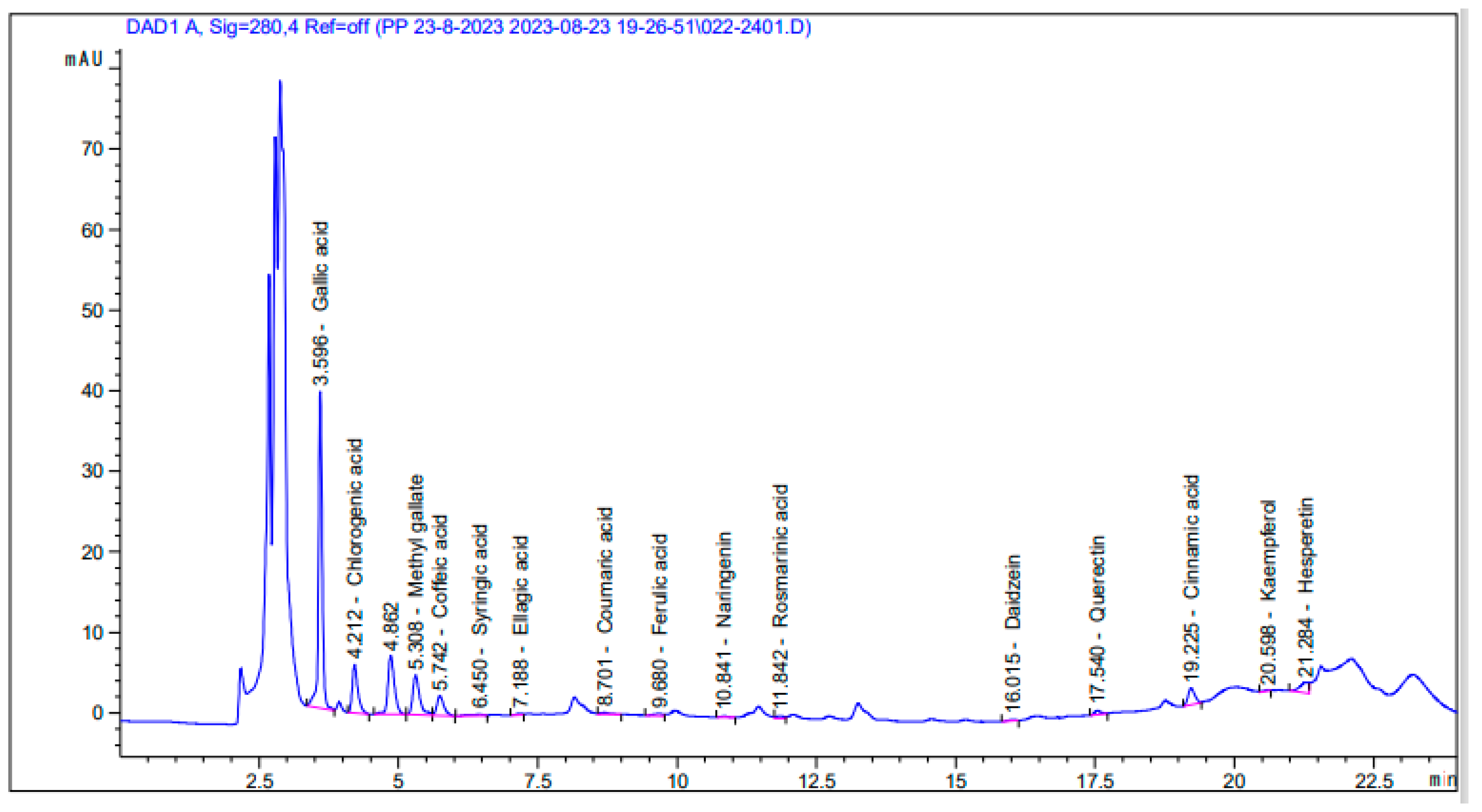
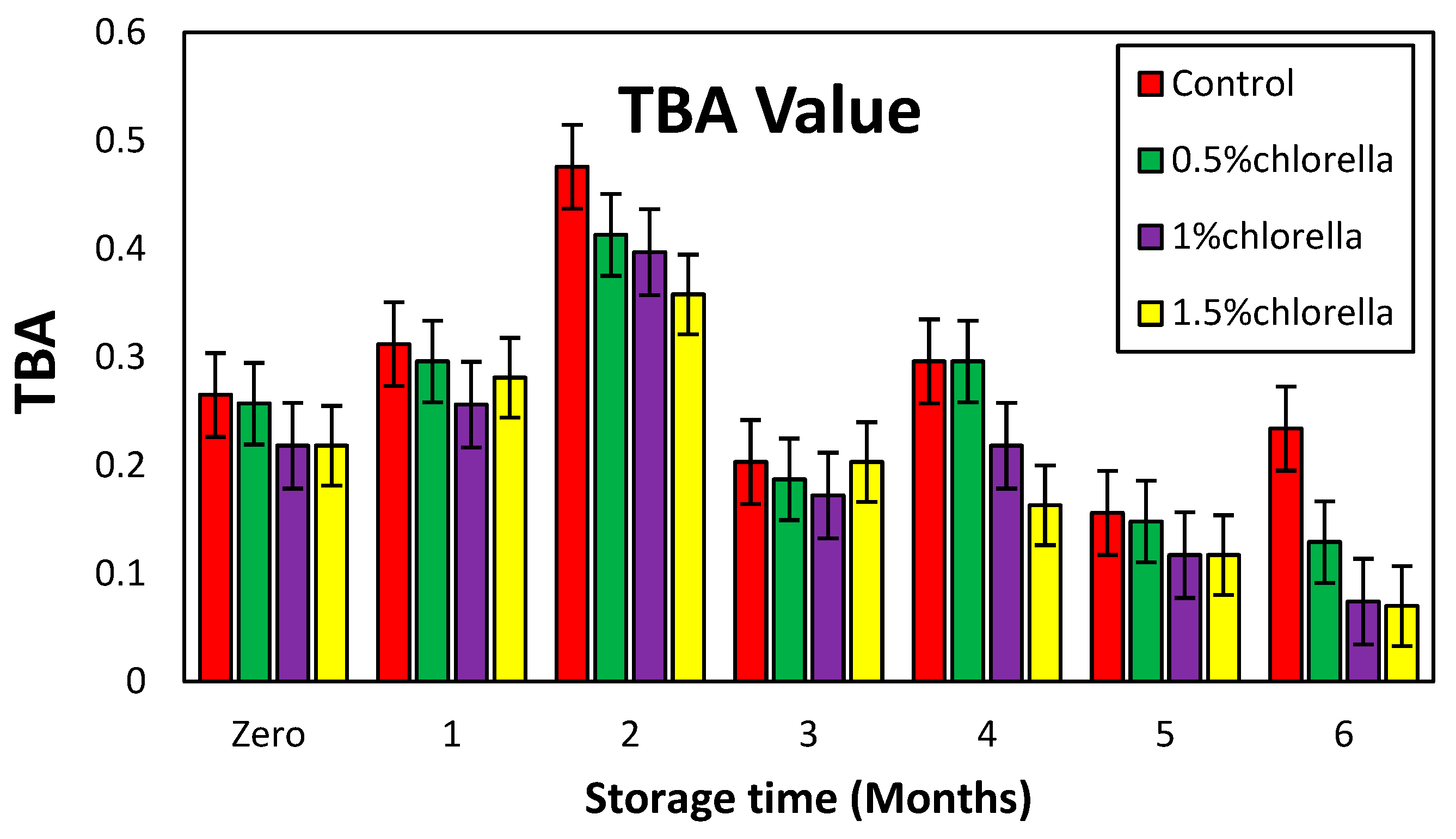
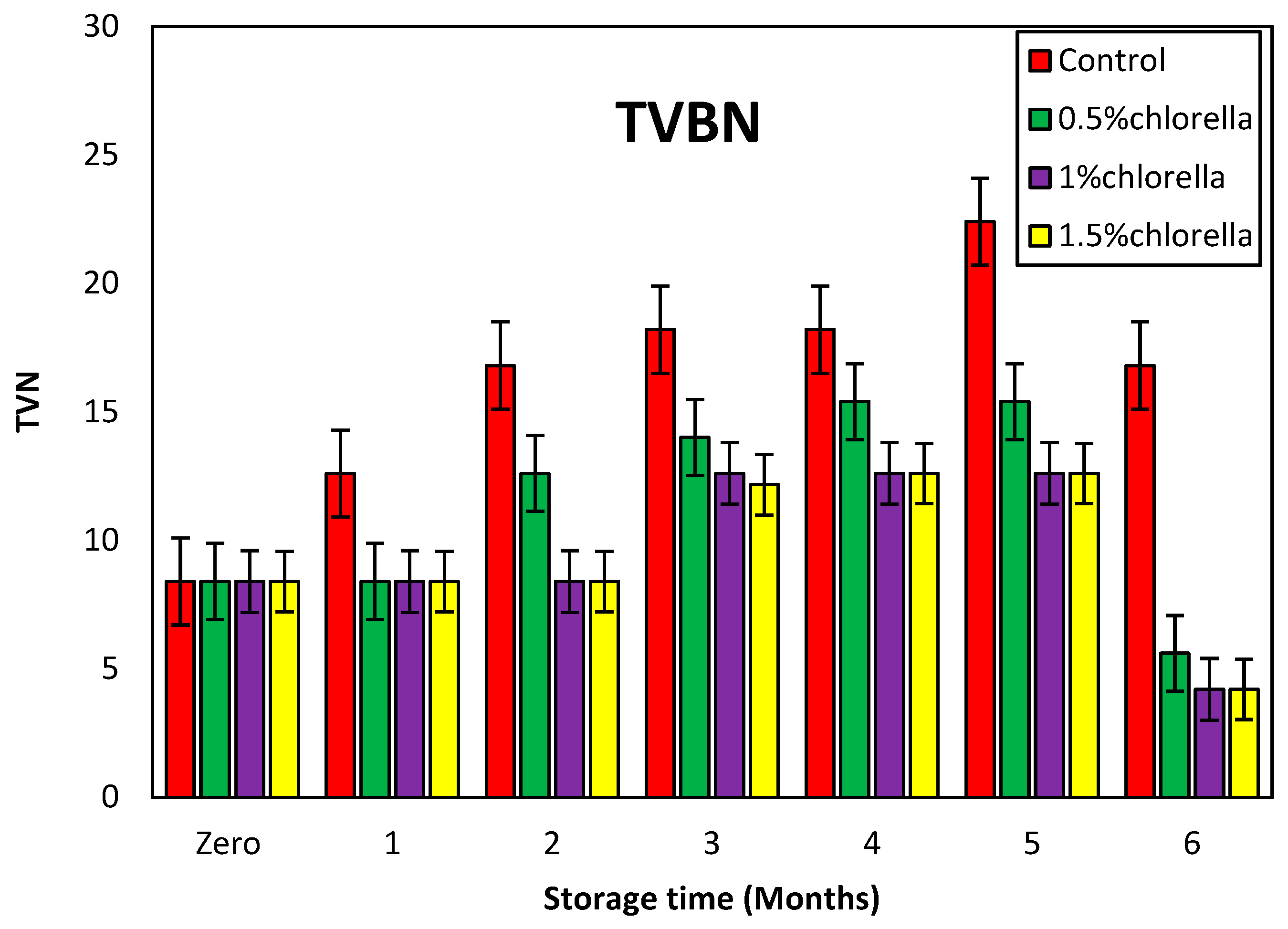
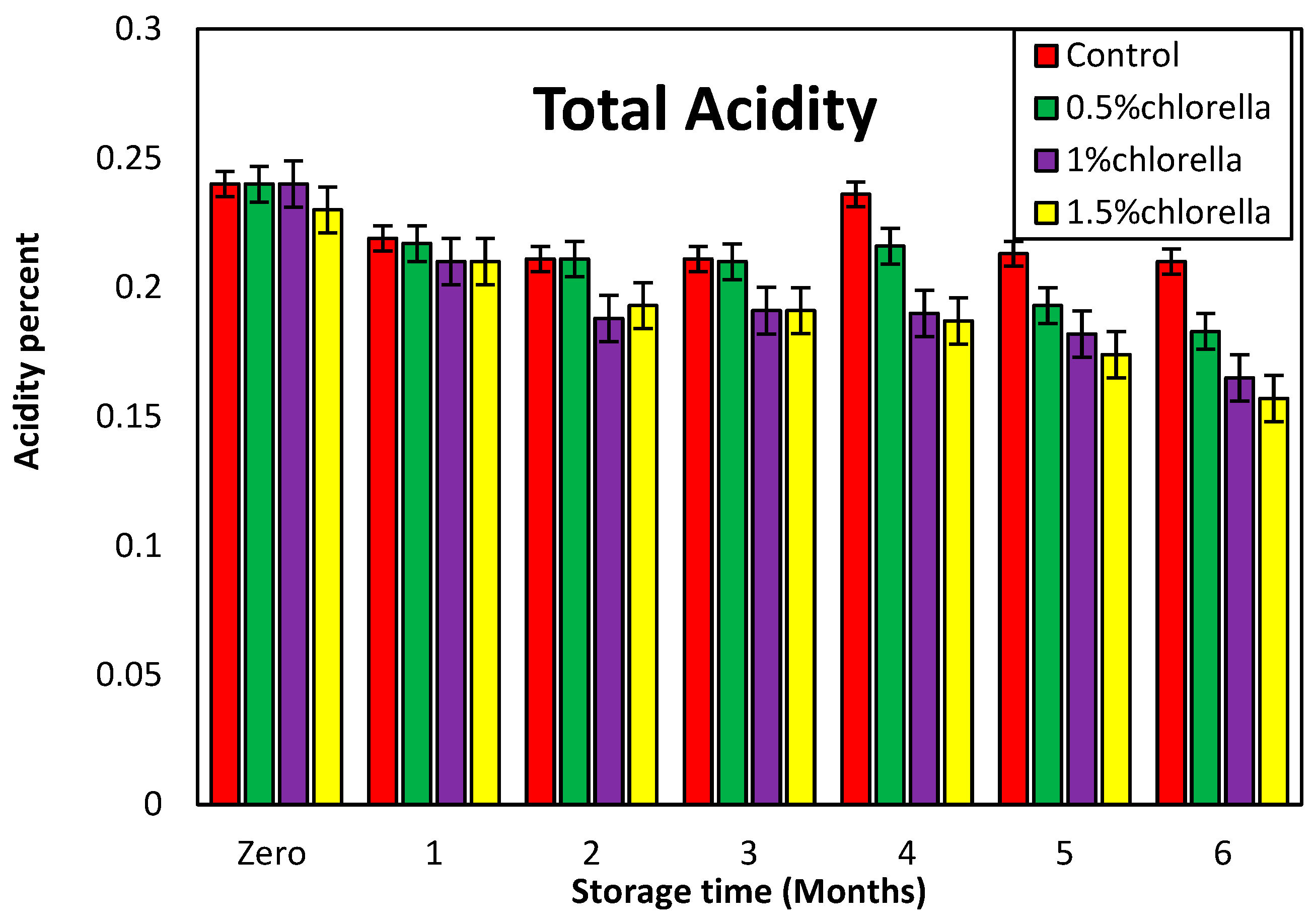
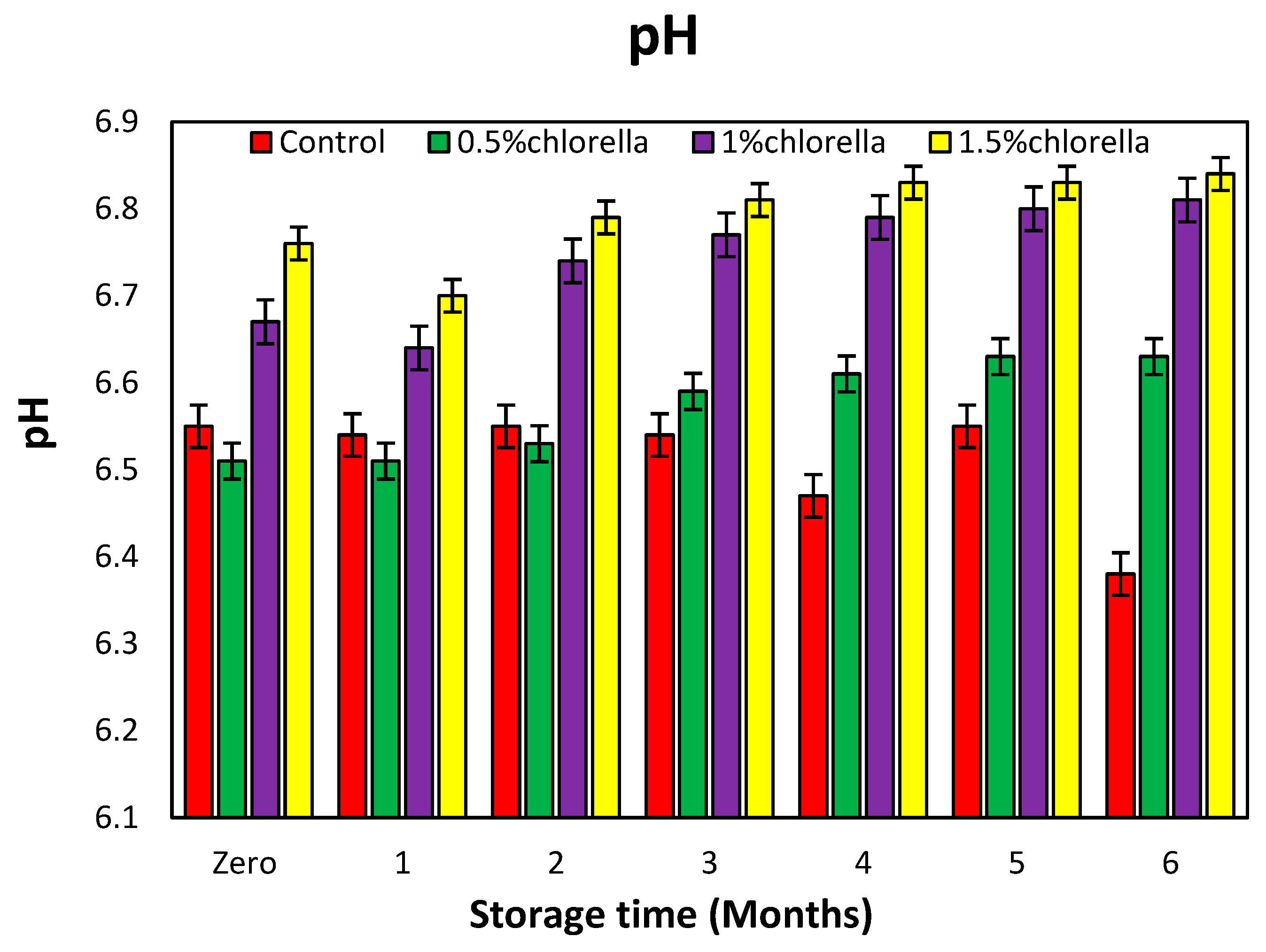
| Parameter | Values |
|---|---|
| Moisture | 10.00 ± 0.17 |
| Ash | 13.00 ± 0.24 |
| Crude protein | 38.17 ± 0.08 |
| Carbohydrate | 21.40 ± 0.17 |
| Crude ether extract | 8.08 ± 0.07 |
| Crude fiber | 9.35 ± 0.06 |
| P (mg/g) | 79.80 ± 1.14 |
| Ca (mg/g) | 0.19 ± 0.01 |
| Na (mg/g) | 51.30 ± 0.90 |
| K (mg/g) | 8.00 ± 0.16 |
| Mg (mg/g) | 2.70 ± 0.33 |
| Fe (µg/g) | 1220 ± 28.58 |
| Mn (µg/g) | 46.00 ± 3.27 |
| Zn (µg/g) | 368 ± 5.72 |
| Cu (µg/g) | 20.00 ± 0.82 |
| Total Chlorophyll (mg/g) | 38.16 ± 0.22 |
| Carotenoids | 17.56 ± 0.24 |
| Extracts | Yield Extract (%) | Total Phenols (mg GAE/g) | Total Flavonoids (mg QE/g) |
|---|---|---|---|
| Ethanol 95% | 25.7 ± 0.49 | 127.7 ± 0.90 | 37.4 ± 1.22 |
| Water | 33.3 ± 0.65 | 183.5 ± 0.81 | 54.0 ± 0.82 |
| Ethanol 50% | 29.0 ± 0.57 | 145.5 ± 2.16 | 51.3 ± 0.41 |
| Components | Area | Conc. (µg/g) |
|---|---|---|
| Gallic acid | 182.62 | 818.81 |
| Chlorogenic acid | 41.99 | 290.23 |
| Methyl gallate | 41.97 | 110.90 |
| Caffeic acid | 21.11 | 88.22 |
| Syringic acid | 2.69 | 10.80 |
| Ellagic acid | 1.39 | 465.77 |
| Coumaric acid | 2.72 | 5.15 |
| Ferulic acid | 2.74 | 21.42 |
| Naringenin | 1.23 | 46.64 |
| Rosmarinic acid | 3.25 | 18.30 |
| Daidzein | 1.13 | 3.34 |
| Quercetin | 4.02 | 73.98 |
| Cinnamic acid | 17.70 | 16.61 |
| Kaempferol | 1.19 | 3.74 |
| Hesperidin | 14.08 | 31.98 |
| Extracts | Conc. (mg/Well) | Inhibition Zone (mm) | ||
|---|---|---|---|---|
| E. coli | Staphylococcus aureus | Bacillus subtilis | ||
| Ethanol 95% | 2.5 | 9 ± 1.63 | 6 ± 0.98 | 8 ± 1.14 |
| 5.0 | 12 ± 0.82 | 10 ± 1.06 | 10 ± 0.16 | |
| Water | 2.5 | - | 4 ± 0.33 | 2 ± 0.20 |
| 5.0 | - | 10 ± 1.80 | 3 ± 0.29 | |
| Ethanol 50% | 2.5 | 8 ± 0.98 | 6 ± 0.41 | 11 ± 0.18 |
| 5.0 | 11 ± 1.80 | 10 ± 0.49 | 13 ± 0.98 | |
| Penicillin | 0.01 | 18 ± 0.90 | 15 ± 0.82 | 14 ± 0.73 |
| Type of Extract Samples | TAC (mg AAE/g) |
|---|---|
| Ethanol 95% extract | 49.6 d ± 1.06 |
| Water extract | 91.6 a ± 1.14 |
| Ethanol 50% extract | 63.2 b ± 0.24 |
| C. vulgaris powder | 57.1 bc ± 0.65 |
| Treatments | Composition% | |||
|---|---|---|---|---|
| Moisture | Protein | Ether Extract | Ash | |
| Control | 64.49 ± 0.20 | 22.45 ± 0.06 | 14.24 ± 0.24 | 2.72 ± 0.25 |
| 0.5% Algae | 65.15 ± 0.05 | 23.68 ± 0.48 | 14.36 ± 0.13 | 2.92 ± 0.07 |
| 1% Algae | 64.50 ± 0.08 | 24.00 ± 0.06 | 14.29 ± 0.25 | 3.14 ± 0.04 |
| 1.5% Algae | 64.88 ± 0.54 | 25.00 ± 0.19 | 14.57 ± 0.34 | 3.33 ± 0.04 |
| ESS | ≤60 | ≥15 | ≤20 | ≤5 |
| Parameters | Storage Time (Months) | Treatments | |||
|---|---|---|---|---|---|
| Control | 0.5%C.V | 1%C.V | 1.5%C.V | ||
| Total bacterial count (log10 cfu/g) | 0 | 5.10 ± 0.16 | 5.03 ± 0.30 | 5.06 ± 0.10 | 5.05 ± 0.08 |
| 1 | 5.06 ± 0.46 | 4.90 ± 0.24 | 4.70 ± 0.34 | 4.80 ± 0.42 | |
| 2 | 4.96 ± 0.78 | 4.70 ± 0.57 | 4.70 ± 0.57 | 4.60 ± 0.18 | |
| 3 | 4.90 ± 0.33 | 4.30 ± 0.16 | 3.80 ± 0.12 | 3.40 ± 0.22 | |
| 4 | 4.30 ± 0.57 | 3.40 ± 0.08 | 3.20 ± 0.18 | 3.00 ± 0.08 | |
| 5 | 4.10 ± 0.08 | 3.00 ± 0.73 | 2.90 ± 0.13 | 2.80 ± 0.24 | |
| 6 | 3.40 ± 0.33 | 2.90 ± 0.37 | 2.70 ± 0.42 | 2.60 ± 0.20 | |
| Reduction% | 33.33 | 42.35 | 46.64 | 48.51 | |
| Total yeast and mold count (log10 cfu/g) | 0 | 3.82 ± 0.26 | 3.81 ± 0.29 | 3.81 ± 0.26 | 3.81 ± 0.07 |
| 1 | 3.80 ± 0.05 | 3.70 ± 0.19 | 3.60 ± 0.29 | 3.60 ± 0.12 | |
| 2 | 3.30 ± 0.43 | 3.20 ± 0.19 | 3.00 ± 0.10 | 2.90 ± 0.11 | |
| 3 | 3.10 ± 0.12 | 2.80 ± 0.22 | 2.70 ± 0.12 | 2.80 ± 0.03 | |
| 4 | 3.10 ± 0.22 | 2.80 ± 0.16 | 2.50 ± 0.02 | 2.30 ± 0.07 | |
| 5 | 3.00 ± 0.14 | 1.40 ± 0.07 | 1.30 ± 0.11 | 1.20 ± 0.06 | |
| 6 | 2.90 ± 0.16 | 1.30 ± 0.01 | 1.17 ± 0.07 | 1.11 ± 0.06 | |
| Reduction% | 24.08 | 65.88 | 69.29 | 70.87 | |
| Total Coliform group count (log10 cfu/g) | 0 | 4.00 ± 0.22 | 4.11 ± 0.04 | 4.11 ± 0.07 | 4.12 ± 0.07 |
| 1 | 4.00 ± 0.29 | 3.80 ± 0.42 | 3.80 ± 0.10 | 3.80 ± 0.03 | |
| 2 | 3.88 ± 0.33 | 3.70 ± 0.07 | 3.50 ± 0.18 | 3.50 ± 0.09 | |
| 3 | 3.70 ± 0.34 | 3.50 ± 0.20 | 3.40 ± 0.25 | 3.30 ± 0.11 | |
| 4 | 3.70 ± 0.16 | 3.30 ± 0.18 | 3.30 ± 0.10 | 3.22 ± 0.12 | |
| 5 | 3.38 ± 0.21 | 3.20 ± 0.19 | 3.00 ± 0.10 | 2.70 ± 0.07 | |
| 6 | 3.20 ± 0.25 | 3.10 ± 0.20 | 2.80 ± 0.12 | 2.50 ± 0.21 | |
| Reduction% | 20.99 | 24.57 | 31.87 | 39.32 | |
| Total Staphylococcus count (log10 cfu/g) | 0 | 4.50 ± 0.12 | 4.47 ± 0.16 | 4.45 ± 0.35 | 4.46 ± 0.15 |
| 1 | 4.46 ± 0.17 | 4.41 ± 0.22 | 4.27 ± 0.19 | 4.23 ± 0.23 | |
| 2 | 4.40 ± 0.23 | 4.08 ± 0.08 | 4.08 ± 0.13 | 3.90 ± 0.15 | |
| 3 | 4.22 ± 0.20 | 3.90 ± 0.33 | 3.80 ± 0.15 | 3.60 ± 0.09 | |
| 4 | 3.95 ± 0.13 | 2.20 ± 0.19 | 2.14 ± 0.11 | 2.00 ± 0.17 | |
| 5 | 3.80 ± 0.18 | 2.00 ± 0.14 | 1.90 ± 0.11 | 1.80 ± 0.02 | |
| 6 | 3.50 ± 0.11 | 1.90 ± 0.07 | 1.70 ± 0.15 | 1.60 ± 0.07 | |
| Reduction% | 22.22 | 57.47 | 61.79 | 64.13 | |
Disclaimer/Publisher’s Note: The statements, opinions and data contained in all publications are solely those of the individual author(s) and contributor(s) and not of MDPI and/or the editor(s). MDPI and/or the editor(s) disclaim responsibility for any injury to people or property resulting from any ideas, methods, instructions or products referred to in the content. |
© 2024 by the authors. Licensee MDPI, Basel, Switzerland. This article is an open access article distributed under the terms and conditions of the Creative Commons Attribution (CC BY) license (https://creativecommons.org/licenses/by/4.0/).
Share and Cite
Abdel-Moatamed, B.R.; El-Fakhrany, A.-E.M.A.; Elneairy, N.A.A.; Shaban, M.M.; Roby, M.H.H. The Impact of Chlorella vulgaris Fortification on the Nutritional Composition and Quality Characteristics of Beef Burgers. Foods 2024, 13, 1945. https://doi.org/10.3390/foods13121945
Abdel-Moatamed BR, El-Fakhrany A-EMA, Elneairy NAA, Shaban MM, Roby MHH. The Impact of Chlorella vulgaris Fortification on the Nutritional Composition and Quality Characteristics of Beef Burgers. Foods. 2024; 13(12):1945. https://doi.org/10.3390/foods13121945
Chicago/Turabian StyleAbdel-Moatamed, Basma R., Alla-Eldeen M. A. El-Fakhrany, Nady A. A. Elneairy, Mohamed Mahmoud Shaban, and Mohamed H. H. Roby. 2024. "The Impact of Chlorella vulgaris Fortification on the Nutritional Composition and Quality Characteristics of Beef Burgers" Foods 13, no. 12: 1945. https://doi.org/10.3390/foods13121945






